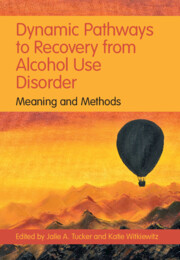Book contents
- Dynamic Pathways to Recovery from Alcohol Use Disorder
- Dynamic Pathways to Recovery from Alcohol Use Disorder
- Copyright page
- Dedication
- Contents
- Figures
- Tables
- Contributors
- Foreword
- Preface
- Acknowledgments
- Introduction
- 1 Historical and Contemporary Perspectives on Pathways to Recovery from Alcohol Use Disorder
- Part I Micro Level
- Part II Meso Level
- Part III Macro Level
- Conclusions and Future Directions
- Index
- References
1 - Historical and Contemporary Perspectives on Pathways to Recovery from Alcohol Use Disorder
from Introduction
Published online by Cambridge University Press: 23 December 2021
- Dynamic Pathways to Recovery from Alcohol Use Disorder
- Dynamic Pathways to Recovery from Alcohol Use Disorder
- Copyright page
- Dedication
- Contents
- Figures
- Tables
- Contributors
- Foreword
- Preface
- Acknowledgments
- Introduction
- 1 Historical and Contemporary Perspectives on Pathways to Recovery from Alcohol Use Disorder
- Part I Micro Level
- Part II Meso Level
- Part III Macro Level
- Conclusions and Future Directions
- Index
- References
Summary
Alcohol use disorder (AUD) has been described as a chronic relapsing condition, yet most individuals who develop AUD will reduce or resolve their problem, and many will “recover.” This chapter summarizes historical and contemporary definitions of recovery, including those developed by key stakeholder groups and definitions based on research with individuals who meet AUD criteria and resolve their problems with or without treatment. The literature supports an expanded definition of recovery as an ongoing dynamic behavior change process characterized by relatively stable improvements in biopsychosocial functioning and purpose in life. Definitions focused solely on abstinence and absence of AUD symptoms do not capture the multidimensional and heterogeneous pathways to recovery found in general population and clinical samples, and non-abstinent recovery is possible. The chapter discusses a shift away from a pathology-based model of recovery towards a strength-based, resilience-building model that recognizes many possible pathways to stable positive change.
Keywords
- Type
- Chapter
- Information
- Dynamic Pathways to Recovery from Alcohol Use DisorderMeaning and Methods, pp. 3 - 22Publisher: Cambridge University PressPrint publication year: 2022



